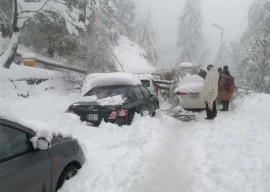
First, the misconceptions surrounding low inflation in Pakistan need to be examined. The low inflation is driven by the reduction in global oil prices from about $100 per barrel in 2013 to about $60 per barrel. Around 40 per cent of power generation in Pakistan is through imported expensive crude oil. Falling oil prices result in lower cost of production. This, along with falling global commodity prices, has resulted in disinflation.
Some quarters have complimented the SBP’s decision for twice cutting interest rates. Theoretically, low interest rates should encourage investors who have been ‘crowded out’ due to high costs of borrowing and disproportionate government spending. However, interest rate cuts have come when commercial bank deposits declined and the government had increased its borrowings from commercial banks. By cutting interest rates the central bank is playing its old game of providing liquidity to the unrestrained government borrowing.
Although the exchange rate is less volatile, the rupee is overvalued. The ‘stable’ currency is due to gifts from foreign patrons and from borrowed money from the sale of around $2 billion of Euro and Sukuk bonds at lofty interest rates. This economic ‘policy’ is far from ideal.
The driver behind our frequent currency crises is our ever-widening trade deficit mainly since our growth in exports has not kept up with our import bill. Since 1990, imports have increased almost six times, while exports have increased only four times, with growth in exports stagnating in the last five years. In the fiscal year (June-January) 2015 alone, our trade deficit has widened to around 16 per cent. These indicators suggest that our local industries face two possibly interrelated problems; they neither possess the ability to compete with global prices, nor have the expertise in producing goods that the rest of the world demands. Due to excessive lobbying from certain sectors, the government subsidises these industries, which are not the most economically efficient, making them uncompetitive. One could be comforted if our imports consisted of buying machinery and capital goods to assist in production. However, most of our imports are consumption goods such as luxury cars, manufactured goods, etc., which do not add significantly to our economy.
Last, the energy sector requires attention. The main issues aggravating the energy sector are related to its low productive capacity, highly inefficient distribution network with high line losses, anaemic governance and a circular debt problem. While the recent Chinese investment in the energy sector might partially fill the vacuum created by our governance structure in the short term, it indicates that the current Pakistani government is indifferent towards the necessary reforms in the energy sector. Unless we are able to undertake significant structural reforms in this sector, the investment will encompass no real medium-to-long-term gains.
With tax reforms looming in the horizon, and a young labour force eager to contribute, one hopes that the government machinery can finally utilise the exciting potential on offer and direct Pakistan on the path to prosperity. Despite the hurdles discussed above, Pakistan can achieve potential growth in the next 1-2 years if it undertakes the critical reforms delayed by successive governments. The facts surrounding the government are indeed changing. How serious it is in adjusting its current economic policies remains to be seen.
Published in The Express Tribune, May 16th, 2015.
Like Opinion & Editorial on Facebook, follow @ETOpEd on Twitter to receive all updates on all our daily pieces.

1736298376-0/Untitled-design-(56)1736298376-0-165x106.webp)





















COMMENTS (1)
Comments are moderated and generally will be posted if they are on-topic and not abusive.
For more information, please see our Comments FAQ